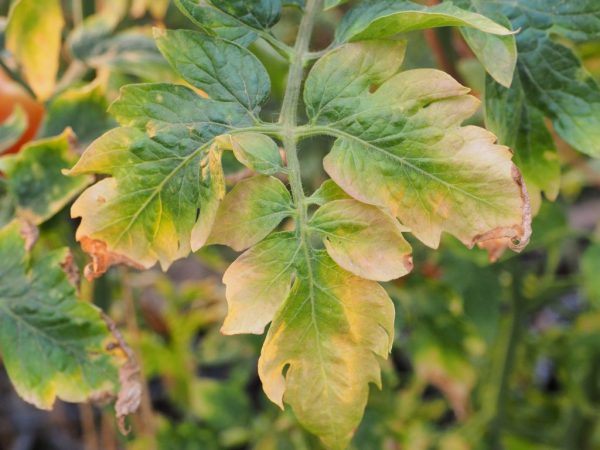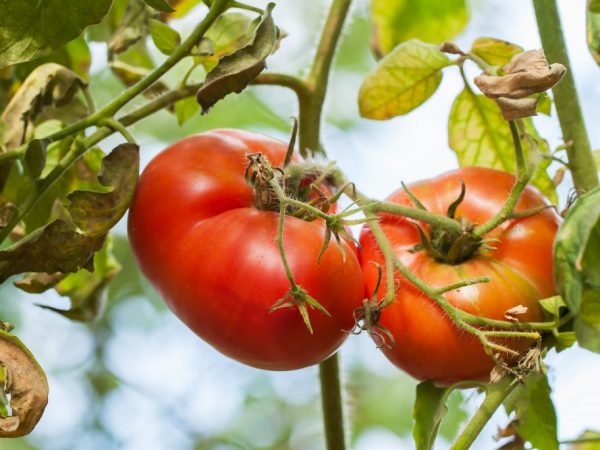Why leaves dry on tomatoes
Often, summer residents when growing tomatoes are faced with the problem of dried tomato foliage. There may be several reasons why the leaves on tomatoes dry, and for each case, their own measures are taken.

Causes of drying leaves on tomatoes
Damage to the root system
One of the reasons why the leaves of tomatoes dry (especially if the edges of the lower leaves and the lower part of the trunk turn yellow and subsequently dry, and other parts of the plant, including the top, outwardly look quite healthy and strong), damage to the root system of the tomato bush often appears.
Control methods
In this case, what needs to be done initially is to pay attention to the process of loosening the soil and weeding tomato bushes after planting in a greenhouse or on an open bed, taking special precautions. The need to be careful when working on a garden bed is due to the fact that a tomato crop of sufficient length has a main central root, from which many small roots feeding the plant branch off. The entire small-root system of a tomato is located quite close to the surface of the earth, its main task is to absorb moisture. From a great depth, this task is assigned to the main root, and from a shallow distance, small roots deliver moisture to the plant. Therefore, if the branched system is damaged in some of its areas, in the lower or at the top, the tomato bush remains without food and immediately reacts to this: the leaves of tomato bushes turn yellow and dry.
Insufficient watering
Lack of drinking is another reason why tomato leaves dry and fall off. With a lack of incoming moisture, tomato bushes begin to wither in the first days, losing the elasticity of the foliage and stem, then the leaves curl, then change color to yellow and subsequently dry up and turn black.
Control methods
Most often, the leaves of tomatoes dry out due to insufficient watering, when young seedlings are watered by gardeners at short intervals, very often, but in small quantities, and then they begin to do it in smaller quantities or stop doing it altogether. Frequent watering leads to the fact that the root system of the tomato bush, which does not extract liquid, begins to grow superficially, without going deep, as a result of which the plant, accustomed to passive drinking, begins to experience a liquid deficit when watering decreases, and the root system does not allow water to be extracted at a depth.
The lack of a plant receiving the required amount of moisture may be due to damage to the central root during transplanting seedlings into open soil. It is he who extracts the bulk of the liquid from the soil layer for the entire tomato bush.
When tomato leaves dry due to insufficient amount of water, reanimate the wilted tomato tops while the leaves have not yet dried, perhaps by pouring out a significant amount of liquid. Subsequently, so that the tops do not dry out and yellow spots do not appear, it is required to saturate the plant with water until the end of the growing season and the fruiting period of tomatoes.
Lack of complementary foods
With a lack of nutrition, the foliage of tomato bushes initially acquires a yellow color, and then turns red in spots. Leaves curl and dry on tomatoes. This process covers the entire tomato bush as a whole, rather than its individual parts.
Control methods

Drying of leaves can be stopped
In the process of full-fledged growth and development of a tomato culture, a lot of mineral elements are required in order to build up green mass, set ovaries on time and form fruits in the future, for which the soil must necessarily contain the required amount of basic mineral components:
- calcium,
- nitrogen,
- phosphorus,
- boron,
- magnesium.
All these components can be found in balanced mineral complexes, which are applied when feeding tomatoes exclusively by the root method after the irrigation procedure or after the last rain. As a good bait for tomato bushes, the introduction of rotted compost or manure into the soil before planting seedlings is used. This natural organic matter saturates the soil layer with a nitrogen component. With proper feeding, the leaves on the tomatoes stop drying.
Lack of lighting
If there is insufficient light in tomato bushes, the foliage begins to shrink, lose its elasticity and firmness, yellow spots appear, the leaves dry out first at the tips, then completely, and as a result fall off. At the same time, the lateral branches of tomatoes from the stem grow in length and become thinner at the top. The stage of inflorescence formation in the plant begins to slow down or does not start at all.
Control methods
Cope with the situation in this case is quite easy: you just need to eliminate the reason for the lack of lighting:
- if tomatoes are grown in a greenhouse, you can add light by placing additional artificial sources,
- if tomato bushes are planted in an insufficiently lit place in an open garden, you can remove closely spaced shrubs and trees that prevent sunlight from entering,
- if it is impossible to create conditions for additional lighting by cutting down on unprotected ground, some resort to little tricks, installing reflective shields made of plywood sheets and covered with foil, or use mirror surfaces and foil insulation.
Hypothermia
When exposed to cold conditions unacceptable for tomatoes, plants begin to slow down their growth. In the absence of primary signs of oppression, the foliage becomes completely yellow with a blue border. The stem takes on a violet or purple hue. Without taking timely measures, the leaves of a tomato bush dry up over time.
Control methods
A number of measures taken in time helps to prevent the development of hypothermia:
- strict adherence to the timing of planting tomato crops in unprotected soil, taking into account the climatic characteristics of the region,
- preferential planting of seedlings in a greenhouse, which prolongs the duration of the vegetative period and fruiting,
- selection of seed material from a series of ultra-ripe tomato varieties that ripen before the onset of the first frost, which occurs at night in late summer.
It is possible to help hypothermic tomato bushes if adaptogens are used, including Epin, Zircon and aloe. The foliage is sprayed with solutions with them, and the bushes are also watered.
Covering plants with a dense material, for example, a film, helps to save plants from hypothermia, but we must not forget that the root system will remain in cold soil.


